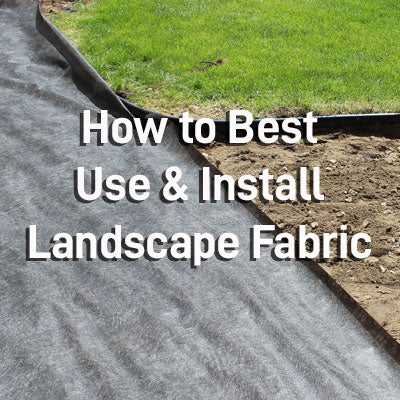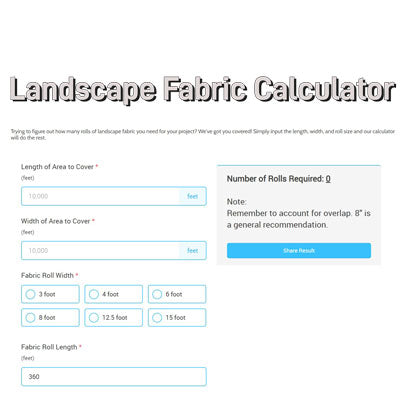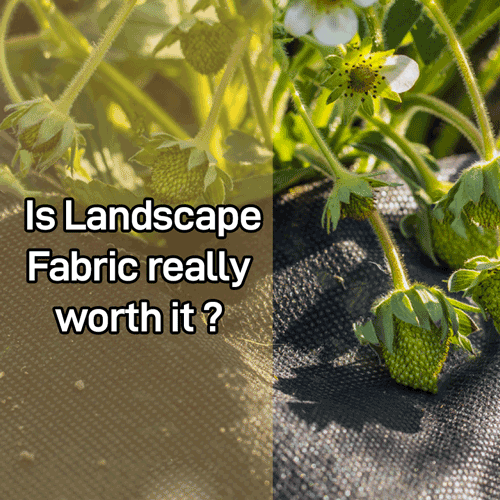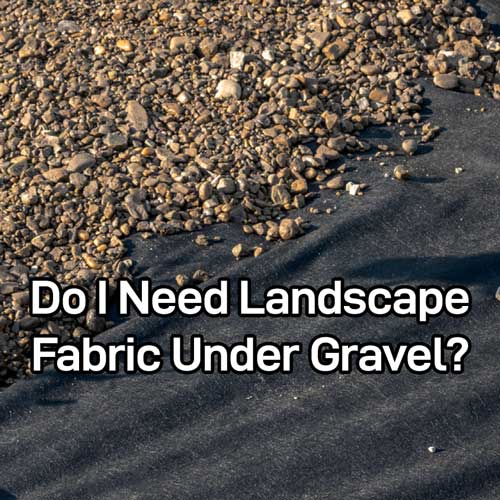Landscape Fabric Calculator
Trying to figure out how many rolls of landscape fabric you need for your project? We've got you covered! Simply input the length, width, and roll size and our calculator will do the rest.
Calculating How Much Fabric You Need For Your Project
How to Calculate How Much Fabric Your Project Needs
- Take measurements of the area: Calculate the width and length of the entire space you intend to cover. You may need to divide these measurements into sections if there are blocked areas that will require using a separate piece of landscaping fabric. These areas could be ones with plants already in place or hills and dips in the soil.
- Compare to landscaping fabric size: Landscaping fabric is found on a roll with varying lengths and widths. 3’, 4’, 6’, 8’, 12.5’ and 15’ are common roll widths with varying lengths. Take note of the landscape area width and the width of the fabric. Comparing these two will determine how many sheets of fabric you will need to cover the space.
- Account for overlapping: If you have to use multiple landscaping fabric pieces, overlapping is essential to prevent plants or weeds from growing between the rows. Overlaps should be approximately 8” wide in general. (Source: Bob Vila).
- Inspect the soil: Take note of flat areas, areas with hills or dips, or plants. Non-flat areas need tight coverage as well. If you have uneven surfaces or plants, measure these areas, as you will either need to place material around them or cut space in the fabric. This is typically done by placing around rows of plants to prevent weeds from growing.
- Subtract overlapping from width: Your final calculation takes the overlapped space and subtracts it from the landscaping fabric's width. This will be the number to see how many rows of fabric are needed. With 5' wide fabric in 15' space, you'll need to take 15' divided by 4'4" (5 feet minus 8 inches for overlap). This equals 4.46 (round up to 5).
- Consider length: While width may be the more math-intensive calculation, considering how long the roll of landscaping fabric is will determine how many you need to purchase. For areas that are shorter in length, you can cut and use additional material to create another row for width.
Quick Measuring Tips
When taking your measurements, use a tape measure to inspect the area for any irregularities or spaces that will need different shapes of landscaping fabric, and write down all calculations.
Once you have determined all of these calculations, draw out a picture with the number of pieces for the area and the calculation numbers alongside them. Creating a visual will help you keep track of all measurements taken and ensure that you do not accidentally forget any areas that will need to be covered.
Make sure that you purchase more fabric than you calculated. We always recommend rounding up on your calculations to ensure the space is fully covered. Extra calculations will depend on how many rows of fabric you will use and the type of project and landscaping fabric used. If you end up with a little bit of extra fabric, there's no real harm done.
These are the general steps you should take for measuring all types of landscape fabric to allow for long-lasting results.

Installing spunbound landscape fabric after measuring.
- Level the soil: This can make a big difference in the amount of landscaping fabric used. When you have many divots or hills in a bed, it will require more material to cover. You should keep the fabric close to the soil's surface and not allow space between a dip and the fabric to exist. Break up clumps of dirt and clay in leveling to use less fabric.
- Properly staple fabric: To put the landscape liner fabric in place and prevent weed growth, use staples. The number of staples used will depend on soil conditions. In looser soil, use more staples and longer ones for security. Hard soil does not need long staples. Any divots should use additional staples to keep the fabric on the surface (Source: Family Handyman).
- Use high-quality landscaping fabric: There is a range of durable and quality products. Most landscape fabric works well for a year before breaking down. This is especially true when using lower quality. While fabric can be expensive, investing in a professional-grade material will save you time and money in limiting the need for replacement.
- Add mulch: Not only is it more visually pleasing, but the mulch will continue to protect the landscape fabric, further block weed growth, and help to maintain moisture for your plants. If you run out of fabric, or do not overlap it enough, mulch can act as an additional layer of protection.

Geotextile Fabric beneath gravel
Applying extra effort and working through all the steps to ensure the area is prepared with the right materials and installed correctly will only benefit your yard in the long run. Not only will you prevent weeds from growing, but the materials will be less likely to wear out prematurely. This ultimately saves you time and energy in replacement or consistent maintenance.
The Type of Project Dictates the Type of Landscaping Fabric
Your project type will dictate which type of landscaping fabric you should use. There are two main categories that landscaping fabrics are broken into woven and non-woven fabrics. Woven fabrics allow for water and air to easily reach the soil beneath, while non-woven fabrics create a greater barrier and are preferred for rocks and gravel.
Here is a breakdown of the different types of landscaping fabrics and when you should use them:
- Woven fabric: We recommend woven fabric for covering flower beds and around trees and shrubs because it stops weeds and traps moisture at the root level. This helps to keep plants healthy. Woven fabrics are typically made of a polypropylene composite. 200lb geotextile fabric is often used to stabilize and increase the life of a gravel driveway. Another use for specific woven fabrics is silt fence fabric which meant to be installed above ground. This helps prevent contamination when working on a construction site and trying to reduce sediment overflow into storm water, rivers, streams and lakes.
- Non-woven fabric: Besides its construction, this fabric is quite similar to woven fabric but differs in it’s enhanced ability to allow water to permeate through the surface and access plants. It is typically made from polyester or polypropylene and can be used in rocky areas as well as flower beds. Heavy-duty versions can be used to reinforce irrigation or retaining walls.
- Hybrid fabrics: Besides its Our commercial grade weed barrier is a hybrid fabric made from a woven geotextile produced by needle punching polypropylene non-woven fibers into the weave to form a high strength fabric with better water permeability.
- Plastic: This material is best used around rocks to limit plant growth and areas with drip irrigation systems. When a weed tarp is used on flower beds, it will be one of the most effective in killing weeds but has the potential to smother or negatively impact plant growth (Source: SFGate). It should be used sparingly in beds compared to fabrics. Our plastic weed prevention membrane does not allow water, sunlight, or air to penetrate into the soil below.
- Perforated fabric: This lighter material is best for areas that will not have considerable plant growth. This is not the best solution for successfully warding off weeds and typically comes with holes for plants to be placed (Source: Lawn Starter).
- Drain field fabric: In areas that need proper drainage between sand, rock, and soil, drain field fabric prevents clogging. This is especially important in preventing pipes from getting clogged. The lightweight material allows water to successfully pass and filter through the material (Source: Garden Guides).
- Frost Block fabric: A frost block fabric helps extend the harvest time and flowering season by keeping the air warmer underneath it than above it. This fabric is available in various roll sizes.
Best Practices for Using Landscape Fabric
The proper installation of landscape fabric is a critical factor that plays into your calculations. This is primarily due to the need for using multiple pieces and allowing for enough overlapping. We have compiled some of the best practices for completing a landscape fabric installation and how you should use the product to achieve the best results in your landscape.
How to Install Landscape Fabric
- Prepare the area: The most crucial parts of installing landscape fabrics are leveling soil, pulling existing weeds or any rocks and debris, and considering the addition of extras to keep the soil nutrient-rich. Common additives come in both organic and inorganic forms, with the most popular being compost and nitrogen fertilizers.
- Unroll the landscape fabric: Place your landscaping fabric along with one of the lengths of your bed or desired area. This will not only be necessary for the first cut but will allow you to visualize how your landscaping fabric will cover the area better (accounting for overlapping as well).
- Place rough side down: Ensure that the textured rough or fuzzy side (depending on the type you use) is facing the soil. This will help the material to adhere to the surface more easily. This configuration is also more effective for allowing water to properly pass through to the soil and plants (Source: North Coast Gardening).
- Cut holes in fabric if applicable: If you are using landscaping fabric around already existing plants, cut slits in the fabric with a knife or scissors and make sure that it surrounds the plant's base. You will create a hole in the fabric and ground for new plants once the fabric has been laid and secured.
- Secure fabric: Make sure the fabric is smoothed across the soil to eliminate bumps (Source: SFGate). Secure the fabric with staples spaced a couple of feet apart, especially at the intersection of two pieces. This includes the edges that should be folded up around the bed or perimeter to prevent weeds in small crevices.
- Cover fabric with mulch: This is important in protecting the fabric from severe weather, maintaining moisture, and blocking weed growth. It also provides a finished appearance to the yard. You should place at least 3 inches of mulch on top of them to prevent full weed growth. If weeds start to grow in the mulch, you can pull them early.

Installed non-woven geotextile fabric.
Pro Tip: Shopping for Landscape Fabric
How you shop for landscape fabric is also vital in making sure you are buying a quality product and getting the amount you need for the project. There are many grades of fabrics available which will directly effect the fabric’s effectiveness. Ensuring that you are purchasing a professional-grade fabric is very important. Often times fabric for sale at big-box stores is economy grade which is typically apparent by the low price. Economy-grade fabric typically translates into economy-grade results.
Using Geogrids and Landscape Fabric
Geogrids are synthetic materials that are often installed to reinforce landscaping construction projects, most commonly soil and retaining walls (Source: The Constructor). Geogrids can be placed on top of soft soil and covered with additional soil layers to keep it strong. This is incredibly helpful in areas that receive more foot traffic to avoid sinking. Geogrids are most commonly used in landscaping to reinforce retaining walls. This is built-in within the cement layers and at the base where the wall makes contact with the soil. While landscaping fabric is not necessary, you can place it on top of the geogrid to prevent weeds from growing around the base of the retaining wall. Landscaping fabric can also be used on top of geogrids when reinforcing soil, especially if you plan to grow plants on top or grow grass in these areas. This will prevent weed growth from making its way through the geogrids and focus growth on your plants and landscaping additions.

Geogrid Fabric installed on a retaining wall.
Benefits and Drawbacks to Using Landscape Fabric
The Benefits of Using Landscape Fabric Include:
- Weed protection: Under gravel weed block fabric is one of the most effective weed-prevention methods. It blocks weeds below the fabric, so they do not contact the nearby plants being grown. This is also an environmentally conscious alternative to using chemicals. For hardscapes, this can help prevent weeds from growing between rock displays (Source: Total Landscape Care).
- Protect soil: While it is not a geogrid, landscape fabric helps reinforce the soil and keep rocks and other debris from getting caught in the soil. Contact with the sun and harsh weather conditions can also wear down the soil and deplete it of nutrients more quickly.
- Moisture retention: Without this layer of protection, soil's direct contact with the sun will increase the need for watering. The weed stop fabric traps moisture to keep plants healthy and hydrated. You should also make sure that the areas do not get too much water, which could cause waterlogging or allow for disease to impact or kill plants.
- Temperature regulation: With the added fabric, the soil will be insulated and maintain more moderate temperatures regardless of outdoor conditions. This will help keep the plant and roots resistant to extreme temperatures (Source: Organic Growers School). Additionally using frost protection cover will help increase the temperature under it for the plants.
- Keeps beds in place: When you use staples to hold the fabric in place, the soil will have difficulty shifting. This is especially true in sloped areas where soil and plants may be more likely to erode. If you live in an area with heavy rainfall, this may be a suitable solution to prevent movements associated with flooding or erosion.
- Drainage: When installing a french drain having a quality drainage fabric wrapped around the rock will significantly increase the life of your drain.
These all contribute to keeping your plants free from intrusion and allowing you to keep your garden low-maintenance. We recommend checking in on the plants and fabric periodically, but these systems are meant to make it easier to maintain your desired landscape appearance. Landscape fabric may need replacement annually or every few years based on the type used.
The Drawbacks of Using Landscape Fabric Include:
- Soil health: One of the most significant concerns in using landscaping fabric is the soil's inability to receive necessary nutrients. Potential waterlogging and an inability to decompose material can prevent the soil from maintaining crucial nutrients for plant health. You can add these nutrients before installing the fabric, but they need to be replaced over time.
- Degradation over time: The fabric will need to be replaced. As time passes, perforations in the fabric may become blocked and prevent plants from receiving needed nutrients and water. You should examine your fabric after a season to judge its condition.
- Doesn't kill all weeds: You may still find that weeds can grow on the surface. These will need to be removed before they penetrate the fabric surface and compromise the system you have put in place.
- Expenses: This is an additional cost that may be unnecessary for your landscaping plans. You will need to factor in the costs of all required materials compared to maintenance that would be required. For many users, this may be worth the time you may spend consistently pulling weeds.
- Time-consuming: Installing landscape fabric is time-intensive, especially if you have lots of flower beds or “complicated” areas to cover (large open areas are very straight forward and can be accomplished fairly quickly). It will take even more time to cover areas that have plants already in place.








